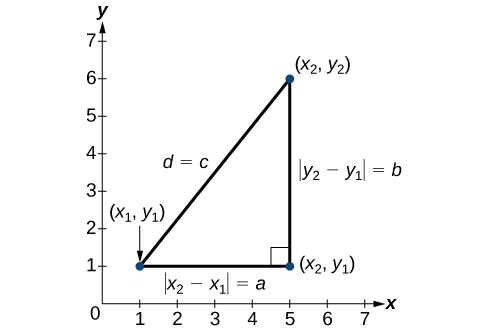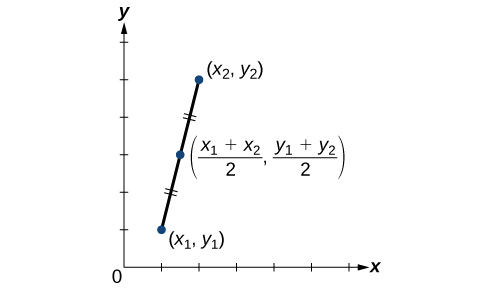Distance in the Coordinate Plane
Learning Outcomes
- Use the distance formula to find the distance between two points in the plane.
- Use the midpoint formula to find the midpoint between two points.
 The relationship of sides and to side d is the same as that of sides a and b to side c. We use the absolute value symbol to indicate that the length is a positive number because the absolute value of any number is positive. (For example, . ) The symbols and indicate that the lengths of the sides of the triangle are positive. To find the length c, take the square root of both sides of the Pythagorean Theorem.
The relationship of sides and to side d is the same as that of sides a and b to side c. We use the absolute value symbol to indicate that the length is a positive number because the absolute value of any number is positive. (For example, . ) The symbols and indicate that the lengths of the sides of the triangle are positive. To find the length c, take the square root of both sides of the Pythagorean Theorem.
A General Note: The Distance Formula
Given endpoints and , the distance between two points is given byExample: Finding the Distance between Two Points
Find the distance between the points and .Answer:
Let us first look at the graph of the two points. Connect the points to form a right triangle.
 Then, calculate the length of d using the distance formula.
Then, calculate the length of d using the distance formula.
Try It
Answer:
Try it
In the graph below, you can move the points around the coordinate plane by clicking on them and dragging them. Try it out to see how the distance between them changes. Choose two points and answer the following questions:- Calculate the lengths of the sides of the triangle made by the two points you chose and the corner point connected to them by green dotted lines.
- What parts of the distance formula are these lengths?
Example: Finding the Distance between Two Locations
Let’s return to the situation introduced at the beginning of this section. Tracie set out from Elmhurst, IL to go to Franklin Park. On the way, she made a few stops to do errands. Each stop is indicated by a red dot. Find the total distance that Tracie traveled. Compare this with the distance between her starting and final positions.Answer:
The first thing we should do is identify ordered pairs to describe each position. If we set the starting position at the origin, we can identify each of the other points by counting units east (right) and north (up) on the grid. For example, the first stop is 1 block east and 1 block north, so it is at . The next stop is 5 blocks to the east so it is at . After that, she traveled 3 blocks east and 2 blocks north to . Lastly, she traveled 4 blocks north to . We can label these points on the grid.
 Next, we can calculate the distance. Note that each grid unit represents 1,000 feet.
Next, we can calculate the distance. Note that each grid unit represents 1,000 feet.
- From her starting location to her first stop at , Tracie might have driven north 1,000 feet and then east 1,000 feet, or vice versa. Either way, she drove 2,000 feet to her first stop.
- Her second stop is at . So from to , Tracie drove east 4,000 feet.
- Her third stop is at . There are a number of routes from to . Whatever route Tracie decided to use, the distance is the same, as there are no angular streets between the two points. Let’s say she drove east 3,000 feet and then north 2,000 feet for a total of 5,000 feet.
- Tracie’s final stop is at . This is a straight drive north from for a total of 4,000 feet.
| From/To | Number of Feet Driven |
|---|---|
| to | 2,000 |
| to | 4,000 |
| to | 5,000 |
| to | 4,000 |
| Total | 15,000 |
Using the Midpoint Formula
When the endpoints of a line segment are known, we can find the point midway between them. This point is known as the midpoint and the formula is known as the midpoint formula. Given the endpoints of a line segment, and , the midpoint formula states how to find the coordinates of the midpoint .
Example: Finding the Midpoint of the Line Segment
Find the midpoint of the line segment with the endpoints and .Answer: Use the formula to find the midpoint of the line segment.
Try It
Find the midpoint of the line segment with endpoints and .Answer:
Example: Finding the Center of a Circle
The diameter of a circle has endpoints and . Find the center of the circle.Answer: The center of a circle is the center or midpoint of its diameter. Thus, the midpoint formula will yield the center point.
Try It
In the graph below, there is a circle with a diameter whose endpoints are (0,5) and (10,5).- Find the center of the circle.
- Place a point at the center of the circle.
- Now move the endpoints of the diameter by clicking on them and dragging them. Notice that the size and location of the circle changes.
- Now graph the center point of a circle of any radius given that the equation for a circle of any radius with any center is .
